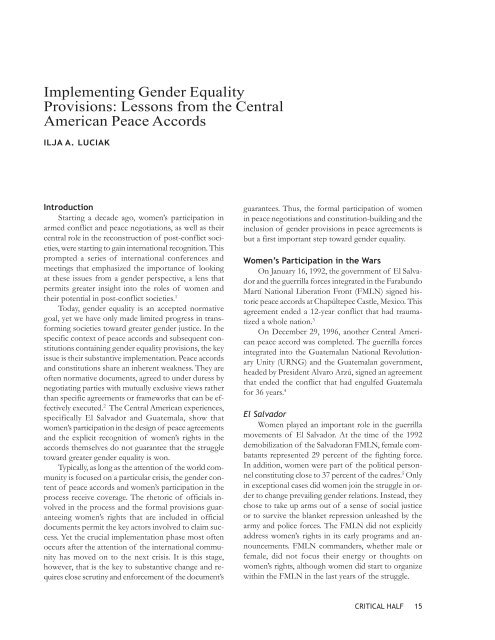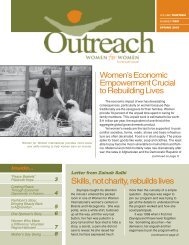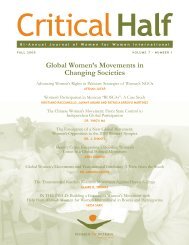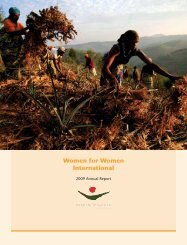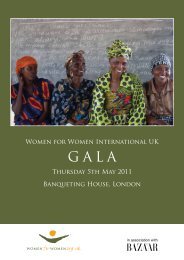Gender and Constitution Building - Women for Women International
Gender and Constitution Building - Women for Women International
Gender and Constitution Building - Women for Women International
You also want an ePaper? Increase the reach of your titles
YUMPU automatically turns print PDFs into web optimized ePapers that Google loves.
Implementing <strong>Gender</strong> Equality<br />
Provisions: Lessons from the Central<br />
American Peace Accords<br />
ILJA A. LUCIAK<br />
Introduction<br />
Starting a decade ago, women’s participation in<br />
armed conflict <strong>and</strong> peace negotiations, as well as their<br />
central role in the reconstruction of post-conflict societies,<br />
were starting to gain international recognition. This<br />
prompted a series of international conferences <strong>and</strong><br />
meetings that emphasized the importance of looking<br />
at these issues from a gender perspective, a lens that<br />
permits greater insight into the roles of women <strong>and</strong><br />
their potential in post-conflict societies. 1<br />
Today, gender equality is an accepted normative<br />
goal, yet we have only made limited progress in trans<strong>for</strong>ming<br />
societies toward greater gender justice. In the<br />
specific context of peace accords <strong>and</strong> subsequent constitutions<br />
containing gender equality provisions, the key<br />
issue is their substantive implementation. Peace accords<br />
<strong>and</strong> constitutions share an inherent weakness. They are<br />
often normative documents, agreed to under duress by<br />
negotiating parties with mutually exclusive views rather<br />
than specific agreements or frameworks that can be effectively<br />
executed. 2 The Central American experiences,<br />
specifically El Salvador <strong>and</strong> Guatemala, show that<br />
women’s participation in the design of peace agreements<br />
<strong>and</strong> the explicit recognition of women’s rights in the<br />
accords themselves do not guarantee that the struggle<br />
toward greater gender equality is won.<br />
Typically, as long as the attention of the world community<br />
is focused on a particular crisis, the gender content<br />
of peace accords <strong>and</strong> women’s participation in the<br />
process receive coverage. The rhetoric of officials involved<br />
in the process <strong>and</strong> the <strong>for</strong>mal provisions guaranteeing<br />
women’s rights that are included in official<br />
documents permit the key actors involved to claim success.<br />
Yet the crucial implementation phase most often<br />
occurs after the attention of the international community<br />
has moved on to the next crisis. It is this stage,<br />
however, that is the key to substantive change <strong>and</strong> requires<br />
close scrutiny <strong>and</strong> en<strong>for</strong>cement of the document’s<br />
guarantees. Thus, the <strong>for</strong>mal participation of women<br />
in peace negotiations <strong>and</strong> constitution-building <strong>and</strong> the<br />
inclusion of gender provisions in peace agreements is<br />
but a first important step toward gender equality.<br />
<strong>Women</strong>’s Participation in the Wars<br />
On January 16, 1992, the government of El Salvador<br />
<strong>and</strong> the guerrilla <strong>for</strong>ces integrated in the Farabundo<br />
Martí National Liberation Front (FMLN) signed historic<br />
peace accords at Chapúltepec Castle, Mexico. This<br />
agreement ended a 12-year conflict that had traumatized<br />
a whole nation. 3<br />
On December 29, 1996, another Central American<br />
peace accord was completed. The guerrilla <strong>for</strong>ces<br />
integrated into the Guatemalan National Revolutionary<br />
Unity (URNG) <strong>and</strong> the Guatemalan government,<br />
headed by President Alvaro Arzú, signed an agreement<br />
that ended the conflict that had engulfed Guatemala<br />
<strong>for</strong> 36 years. 4<br />
El Salvador<br />
<strong>Women</strong> played an important role in the guerrilla<br />
movements of El Salvador. At the time of the 1992<br />
demobilization of the Salvadoran FMLN, female combatants<br />
represented 29 percent of the fighting <strong>for</strong>ce.<br />
In addition, women were part of the political personnel<br />
constituting close to 37 percent of the cadres. 5 Only<br />
in exceptional cases did women join the struggle in order<br />
to change prevailing gender relations. Instead, they<br />
chose to take up arms out of a sense of social justice<br />
or to survive the blanket repression unleashed by the<br />
army <strong>and</strong> police <strong>for</strong>ces. The FMLN did not explicitly<br />
address women’s rights in its early programs <strong>and</strong> announcements.<br />
FMLN comm<strong>and</strong>ers, whether male or<br />
female, did not focus their energy or thoughts on<br />
women’s rights, although women did start to organize<br />
within the FMLN in the last years of the struggle.<br />
CRITICAL HALF 15


